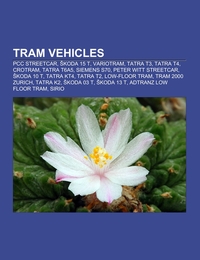Detailansicht
Tram vehicles
PCC streetcar, Skoda 15 T, Variotram, Tatra T3, Tatra T4, CROTRAM, Tatra T6A5, Siemens S70, Peter Witt streetcar, Skoda 10 T, Tatra KT4, Tatra T2, Low-floor tram, Tram 2000 Zurich, Tatra K2, Skoda 03 T, Skoda 13 T, ADtranz low floor tram
ISBN/EAN: 9781157617013
Umbreit-Nr.: 3733446
Sprache:
Englisch
Umfang: 36 S.
Format in cm: 0.2 x 24.6 x 18.9
Einband:
kartoniertes Buch
Erschienen am 08.06.2012
Auflage: 1/2012
- Zusatztext
- Source: Wikipedia. Pages: 35. Chapters: PCC streetcar, Skoda 15 T, Variotram, Tatra T3, Tatra T4, CROTRAM, Tatra T6A5, Siemens S70, Peter Witt streetcar, Skoda 10 T, Tatra KT4, Tatra T2, Low-floor tram, Tram 2000 Zurich, Tatra K2, Skoda 03 T, Skoda 13 T, ADtranz low floor tram, Sirio, Tatra T6A2, Skoda 19 T, Auckland Tram Number 304, TMK 2100, TMK 101, Tatra T1, Tatra T5C5, Skoda 16 T, Ultra Low Floor, Skoda 14 T, TMK 201, Double-decker tram, Incentro, Skoda 06 T, Skoda 05 T, Tatra K1, Tatra K5AR, PESA 122N, PESA 120N, PESA 120Na, PESA 121N, Konstal 805Nm, Tatra T5A5, Tatra T5B6, GT4. Excerpt: The PCC (Presidents' Conference Committee) streetcar (tram) design was first built in the United States in the 1930s. The design proved successful in its native country, and after World War II was licensed for use elsewhere in the world. The PCC car has proved to be a long-lasting icon of streetcar design, and PCC cars are still in service in various places around the world. The PCC name comes from the design committee formed in 1929 representing the Presidents of various electric street railways. The Electric Railway Presidents' Conference Committee, or ERPCC, was tasked with producing a new type of streetcar that would help fend off competition from buses and automobiles. The committee conducted extensive research, prepared a detailed research program, built and tested components, made necessary modifications, and produced a high-performance design that was commonly used in the following decades. The cars were popular because of their distinctive streamlined design and smooth acceleration and braking. The design patents were held by a business called the Transit Research Corporation, who licensed features to various streetcar manufacturers. It turned out that the PCC streetcar was a very good design. The standard car was 46 ft (14.0 m) long and 100 in (2.54 m) wide with later models 46.5 ft (14.2 m) long and 108 in (2.74 m) wide. Chicago, Detroit, Illinois Terminal, Pacific Electric, and San Francisco had longer cars, as long as 50.5 ft (15.4 m). Washington, D.C., had shorter cars (44 ft (13.4 m)) because of transfer table clearances. Many railways altered the car in various ways to fit their own needs, but most cars retained a standard appearance. Although a participant in Committee meetings, trolley manufacturer J. G. Brill and Company brought a competitive design-the Brilliner-to market in 1938. With Raymond Loewy designed elements, very similar to the PCC look, the Brilliner attracted no large orders, serving most conspicuously with Atlantic City Transit. Fewe
